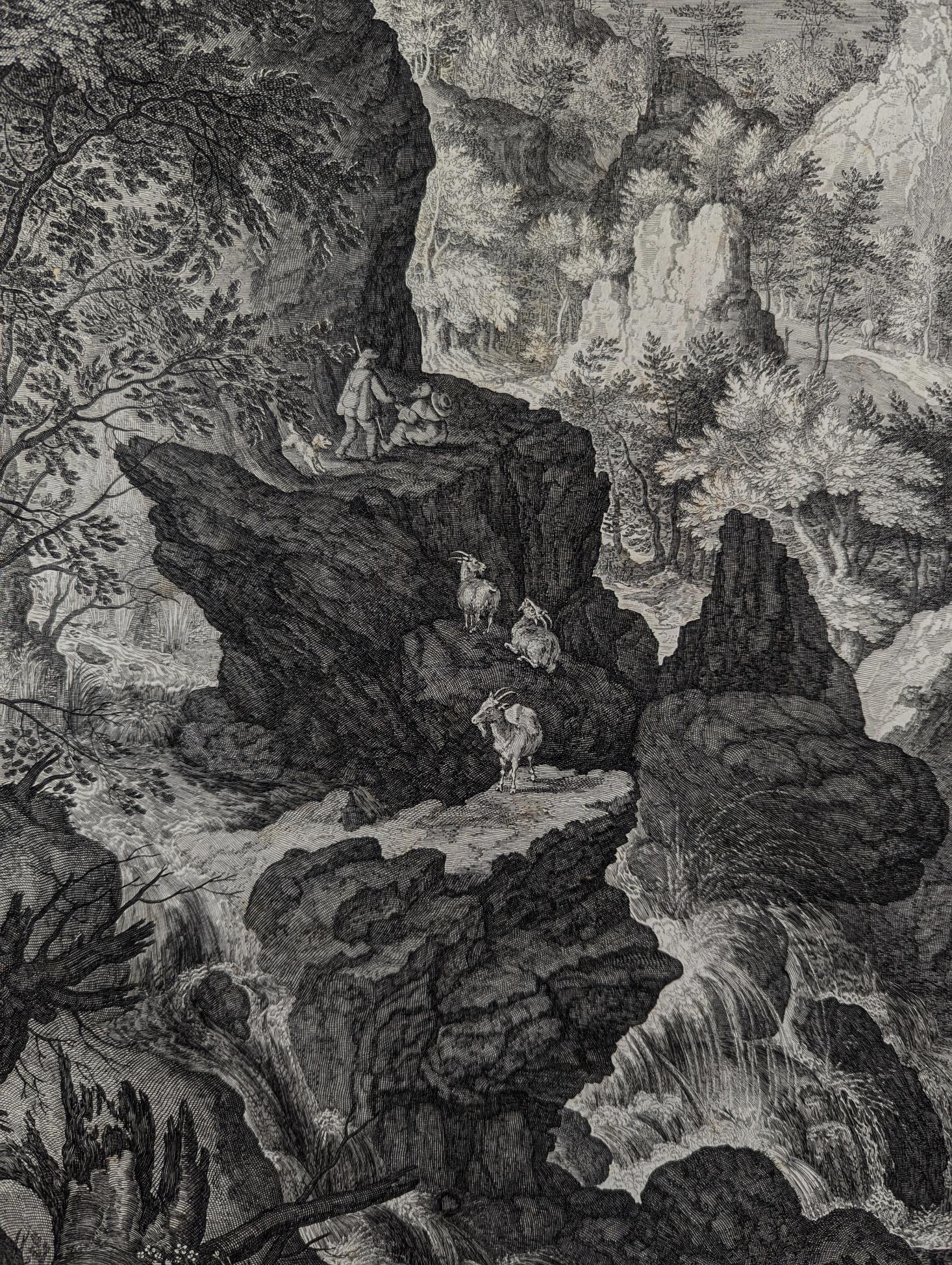RARE OLD MASTER PRINTS
No.16 - March 2023



No.16 - March 2023




We are pleased to present in this catalog n°16 a selection of rare Old Master prints from the 16th to the early 19th century. Among the 16th century prints, let us note in particular these rare or very rare first state proofs: Dido’s Suicide (1520) by Hans Sebald BEHAM, before copperplate reduction; A Sacrifice (c.1540 /1545) by Leon DAVENT, before the letter and the reduction of the copperplate; Big Fish Eat Little Fish (1557) engraved by Pieter van HEYDEN after the drawing of Pieter BRUEGEL the Elder, before erasing of the address of Hieronymus Cock; Sirens, Naiads and Tritons (c.1563) by Angelo FALCONETTO, before the signature of the artist.
We also present a very rare heightened color impression of The Temptation of Saint Anthony (1561) engraved by Johannes and Lucas van DOETECUM after a drawing attributed to Hieronymus BOSCH.
Very rare also are the impressions of David and Abigail (1509) by Lucas CRANACH, The Temptation of Christ (1525) by Dirck Jacobsz. VELLERT, Cassandra Stopping Deiphobe from Killing Paris (c. 1544/1545), Landscape with the Rest on the Flight into Egypt (c.1550/1555) by Sebastiano de VALENTINIS, Conversion of Saint Paul (1576) engraved by Cornelis CORT, Humanae vitae finis (1589) by Bernardino PASSERI and the Nymphaeum [The Women's Bath] by Robert BOISSARD.

Among the 17th century prints, we note the rare complete series of eight plates in the 1st state of the Market by Jan van de VELDE II and a rare 2nd state impression of the Woman with a High Headdress Wrapped Around the Chin: bust by REMBRANDT.
At the beginning of the 19th century, the probably unique impression of Nicolas-Henri JACOB's Head of an Amazon for which the way the stone is inked has been reversed and printed by the artist in company of the inventor of lithography, Aloys SENEFELDER, in his workshop in the rue de l'Abbaye in Paris, testifies to the hard work of these artists to develop this revolutionary technique.
Finally, the Self-portrait at the age of twenty-eight, in bust, front view by Adam BARTSCH does not only evoke the connoisseur of Old Master prints, whose name we often meet in our research followed by a catalog number. It also evokes the generations of collectors, experts, curators and dealers who participated in the research, documentation and conservation of old prints. Today, we are modestly trying to contribute to the preservation of these fragile prints, which have survived the centuries thanks to their attentive care.
Maurice and Sarah Sauvin.(1472 - 1553)
David and Abigail - 1509
Woodcut, 245 x 176 mm. Hollstein 3, Bartsch 122.

Very fine impression printed on watermarked laid paper (part of lily). The imprint of the woodblock is clearly visible on the reverse of the sheet. A tiny brown stain and a few pale foxmarks; very light soiling in the centre of the plate, otherwise in excellent condition. Thread margins all around the platemark. Broken borderlines, often completed in ink, are intact on this impression.
Impressions of this print are very rare, as highlighted by the anonymous annotation on the reverse in graphite:

außerordentlich selten [exceptionally rare!]
The scene represents the meeting between David and Abigail, wife of Nabal. By offering David some gifts, Abigail begs him to forgive the ingratitude of her husband who refused to thank him for having protected her lands and herds. After Nabal's death, David will marry Abigail.
The winged serpent engraved between Lucas Cranach's initials and the date 1509 is his signature. The electoral and ducal arms of Saxony hanging on the tree are a reminder that Cranach was in the service of Frederick III of Saxony and enjoyed his protection.
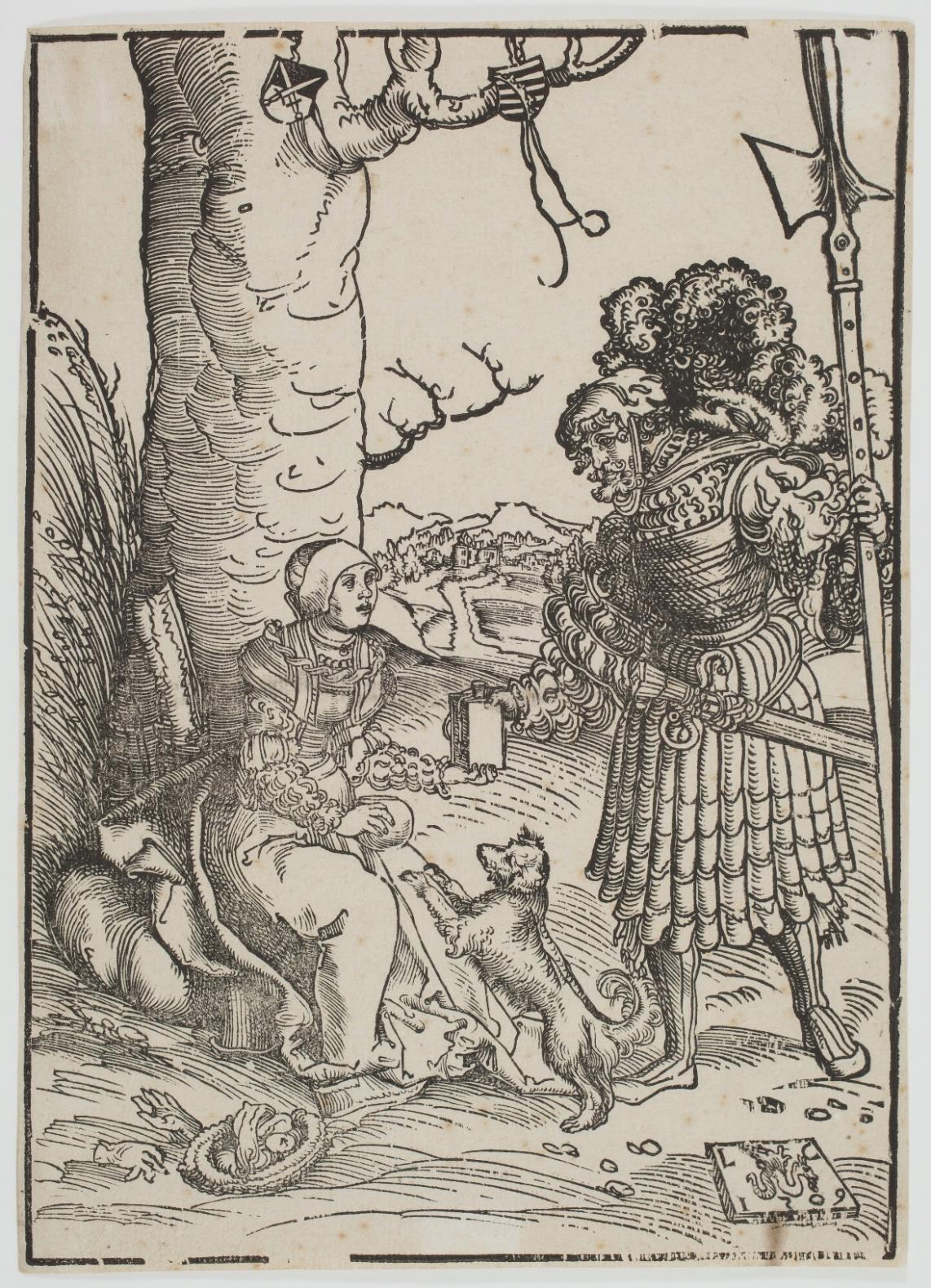

Dido’s Suicide - 1520


Engraving, 130 x 96 mm. Bartsch 80 undescribed state, Pauli 84, 1st state (of 2)
Very rare impression of the first state (of 2), before the reduction of the plate.


Very fine impression printed on laid paper. Impression trimmed 1 mm outside the image on three sides, to the borderline at the left sheet edge and very slightly inside the image in the bottom left corner. In very good condition. A thin vertical fold almost invisible on the recto of the sheet.
Provenance:
- collection D. G. de Arozarena (c.1860) (Lugt 109). This impression is number 44 of his March 1861 sale (Paris, expert Clément): "Magnificent impression of a first state unknown to Bartsch, before the plate was reduced".
- collection Graf Ludwig Yorck von Wartenburg (Lugt 2669). This impresssion is number 231 of his May 1932 sale (Leipzig, C. G. Boerner) : "Erster Abdruck von seltener Schönheit. Vor Verkleinerung der Platte. Von P. angeführtes Exemplar und aus der Sammlung Arozarena." [First impression of a rare beauty. Before reduction of the plate. Copy quoted by P[auli] from the Arozarena collection].
- collection Pierre Lallier (1946-2021), printer (Lugt undescribed).
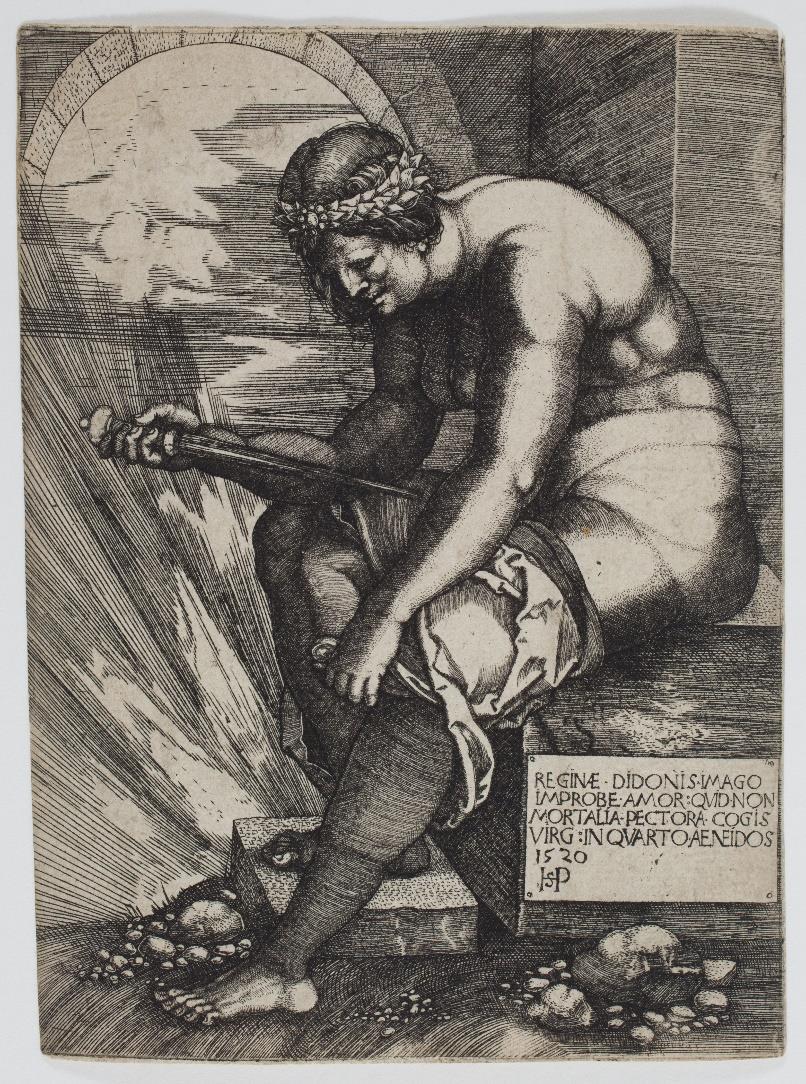

This impression is cited by Pauli ("Klein Oels, Graf York") and Hollstein.

Adam Bartsch describes only the 2nd state, as indicated by the dimensions mentioned (4 inches 4 lines x 3 inches 4 lines) corresponding to the copper reduced to 119 x 90 mm. He also makes a mistake on the date that is engraved.
Pauli notes: "The figure is partly original and partly copied from the Venus of Mark Anton (Marc Antonio Raimondi)". (translated by us). If the two compositions indeed present similarities, the tragic figure of Dido is far from resembling Raimondi's Venus, quietly leaning forward to perform the harmless gesture of wiping her foot: while Venus's bent leg, bent face and outstretched arm express the grace of the goddess, Dido's bent back, slumped shoulder and hanging arm mark her despair.
Marcantonio RAIMONDI
Venus drying her foot with a piece of drapery, Cupid in front of her, holding a bow in his left hand (1510/1527). Metropolitan Museum of Art

In most of the works representing Dido's suicide, the grieving Queen of Carthage pierces her chest or side with a theatrical gesture. Nothing of the sort in Sebald Beham's engraving: Dido is seated, her back bent, her clothes undone, her right arm resting on her thigh, her hand firmly holding the dagger directed towards her belly. The threatening straight blade of the dagger contrasts with the slumped, almost deformed body. In this dramatic episode of Book IV of the Aeneid, Dido had a pyre prepared and invited her compagnes, without revealing her fatal plan, which they realize only when they discover her blood-spattered hands. Beham only retains the strength of soul of the queen whose stoic attitude and the hand firmly holding the dagger illustrate her resolution: moriemur inultae sed moriamur: we will die not avenged, but let us die!


(c. 1480 - after 1547)
The Temptation of Christ - 1525
Engraving, 113 x 76 mm. Hollstein 5, 2nd state (of 2), Bartsch (Thiery van Star) 5.
Impression of the 2nd state (of 2) with the additional lines on the devil’s leg. Impressions of the first state are very rare. Fine impression printed on laid paper, trimmed on the borderline. A horizontal fold visible only on the back of the sheet. Generally in good condition.
Adam Bartsch writes: "Dirk (Thiery) van Star, i.e. Etoile, is the name of a very skilful engraver of whom we have no other record, except that he was Dutch, and that he lived between the years 1522 and 1544." (Le Peintre graveur, volume 8, p. 26, translated by us). The monogram has been interpreted by Gustave Glück as that of Dirk Vellert, a Flemish painter and stained-glass artist. Almost all of Vellert's nineteen intaglio prints date from the first half of the 1520s, and the artist often even engraved the month and day. The Temptation of Christ is dated April 2, 1525.
Impressions of prints by Dirk Vellert are very rare.
The influence of Lucas van Leyden and Albrecht Dürer can be seen in the composition of The Temptation of Christ. Arthur Popham has compared the figure of the devil to the one engraved by Lucas van Leyden in 1518 (Bartsch 41).
Vellert's technique differs, however. Nadine Orenstein underlines in particular “the artist’s ability to manipulate the burin in a way that suggests a draftsman-like expressiveness.” (N. Orenstein, F. Spira, P. Fuhring & C. Jenkins: The Renaissance of etching, 2019, p. 68).






4. Léon DAVENT (active c. 1540 - 1556) after Francesco PRIMATICCIO (1503 - 1570)
Etching, 275 x 490 mm. Jenkins LD39, 1st state (of 3), Zerner 39, Bartsch 14.
Impression of the first state before the inscription His, et talibus monumentis olim ornata fuit […], before Antonio Lafreri’s address and the date 1565. “Early impressions” (“premières épreuves” according to Bartsch, Le Peintre-graveur, vol. 16, p. 315), that is impressions from the first state, are very rare. Superb impression printed on laid paper; a few pale foxmarks; generally in excellent condition. Thread margins all around the platemark.
“This print, after a drawing by Primaticcio executed in Rome (inv. 584 Städel Museum, Frankfurt; Malke, 1980, no. 84), relates closely to a section of Trajan’s Column (LXVI/XCI) that depicts the Emperor Trajan at an altar in the presence of Romans and Dacians, women and children (illustrated in Coarelli, 2000, pp. 150-151, plates 106 and 107).” Catherine Jenkins: Prints at the Court of Fontainebleau, c. 1542-47, 2017, p. 58)






5. Jean MIGNON (active c. 1535 - 1555) after Luca PENNI (c. 1500 - 1566)
Cassandra Stopping Deiphobus from Killing Paris -c. 1544/1545
Etching, 320 x 445 mm. Jenkins JM43, Zerner JM43, Bartsch 46.

Very fine impression printed on laid watermarked paper (watermark: grapes). A 20 cm repaired tear in the left part, almost invisible on the recto, a very light stain in the bottom. Thread margins all around the platemark.
Very rare.
“

Long identified as the Treacherous Sinon in the Camp of the Trojans, this composition is now thought to represent Cassandra preventing Deiphobus from killing their brother Paris, who was the victor in the funerary games held in his memory in the mistaken belief that he was dead (Cordellier, 2012 (1), pp. 4849).” (Catherine Jenkins: Prints at the Court of Fontainebleau, c. 1542-47, 2017, vol. 2, p. 308).
Cassandra Stopping Deiphobus from Killing Paris is part of a set of five other etchings of the same dimensions engraved by Jean Mignon after models by Luca Penni, relating episodes of the Trojan War (Jenkins JM40 à 45): Judgment of Paris, Abduction of Helen, Battle before Troy, The Troyans Bringing the Wooden Horse into their City, Battle in the Palace of Priam.



Landscape with the Rest on the Flight into Egypt - c. 1550/1555
Etching and engraving, 208 x 140 mm (sheet). Bartsch 1, Le Blanc 1.
Very fine impression printed on laid paper. A tiny surface abrasion on the left edge in the centre, a tiny wormhole at the top of the tree. A few light spots. Impression trimmed 1 mm inside the subject at the bottom, barely 1 mm on the right side at the top, and barely 1 mm in the upper left corner.
Provenance: Pierre Mariette II. His signature written in pen and ink on the back, with the date 1675 : P. mariette 1675 (Lugt 1789).

Impressions of this print are very rare.
Adam Bartsch lists only two prints engraved by Sebastiano de' Valentinis: Landscape with the Rest on the Flight into Egypt and Prometheus. Today he is credited with a march of the Turkish army dated 1558.
In the two prints catalogued by Bartsch, a mountain landscape serves as a frame for the scene depicted: rocks and trees or shrubs occupy the right and lower part of the print, a distant city is outlined in the left part. But while in Prometheus the massive figure of the hero occupies the center of the print and relegates the landscape to the background, the landscape plays an important role in Rest in Egypt, as David Acton notes: "It is the remarkable landscape that creates the mood of this image". (David Acton, Italian Etchers, p. 38).
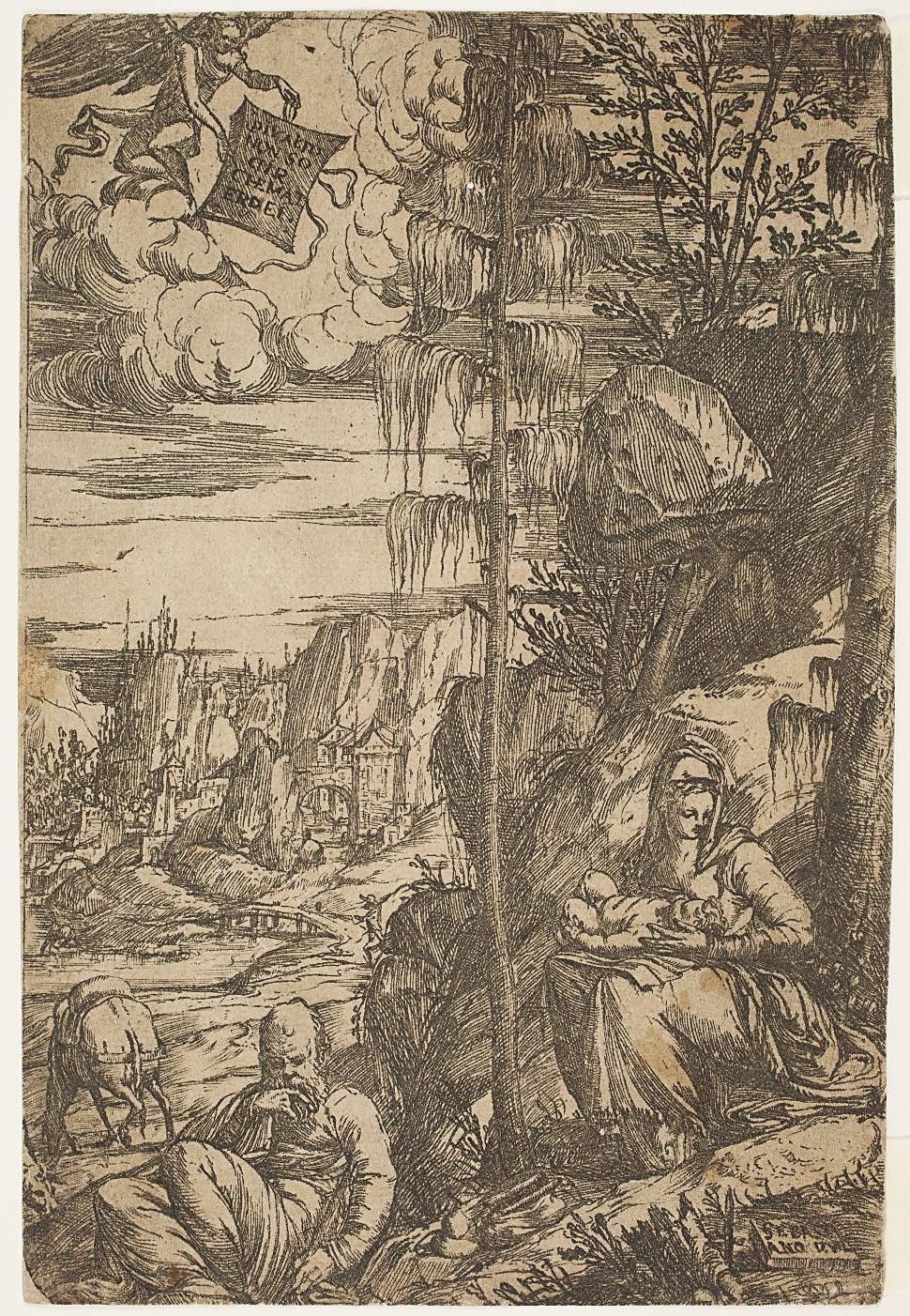

If the Virgin, Joseph and the baby Jesus, as well as their mount drinking from a stream, are represented in the foreground, their figures do not occupy the center of the image as is the case with Prometheus: the central figure of Landscape with the Rest on the Flight into Egypt is a very large shrub whose tapered trunk and tiered foliage guide the viewer's gaze towards the sky, where there is an angel presenting a tablet bearing this message: PIU ALTO NON SO DIR CHE MATER DEI [“I know of none higher than the Mother of God.]

The influence of the printmakers of the so-called Danube School, such as Albrecht Altdorfer and Wolfgang Huber, has often been noted in this landscape. David Acton rather identifies his style and figures with the art of Domenico Campagnola.




7. Pieter van der HEYDEN (c. 1530 - after 1572)
after Pieter BRUEGEL The Elder (c. 1525 - 1569)
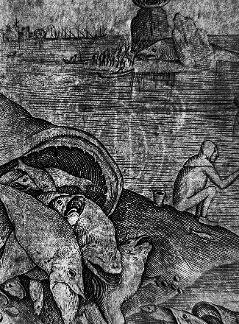
Engraving, 232 x 295 mm. New Hollstein (Bruegel) 3, 1st state (of 4); New Hollstein (Heyden 146); Hollstein (Bosch) 23.
Impression of the first state (of 4), with Hieronymus Cock’s address.

Fine impression printed on laid watermarked paper: Two crowned Cs intersecting around the cross of Lorraine, similar to Briquet 9327 (Maëstricht, 1596).
Three thin areas on the reverse, one backed, a tiny triangular repaired loss of paper bottom right, a thread, a thin vertical handling or printing crease to the left of the gaping mouth of the fish. Generally in good condition.
Very rare.
Manfred Sellink points out that "the metaphor 'the big fish eat the little fish', which illustrates the enrichment of the powerful at the expense of the poor, spread throughout Europe from antiquity and became very popular in Antwerp, a city of printers, precisely in the 16th century." He points out, however, that in Bruegel's drawing "the largest and most gluttonous fish is thrown back on the shore and disemboweled, so that all the swallowed fish come out of his body and the result of his greed is destroyed." (Manfred Sellink, Bruegel, lʹ œuvre complet - peintures, dessins, gravures, 2007, p. 88, translated by us).
The preparatory drawing for this print, kept in the Albertina in Vienna (inv. 7875), is signed by Bruegel and dated 1556. It is thought that the name Hieronymus Bosch (died 1516) engraved on the print was a commercial choice by Hieronymus Cock, as Bruegel's name was not yet well known.

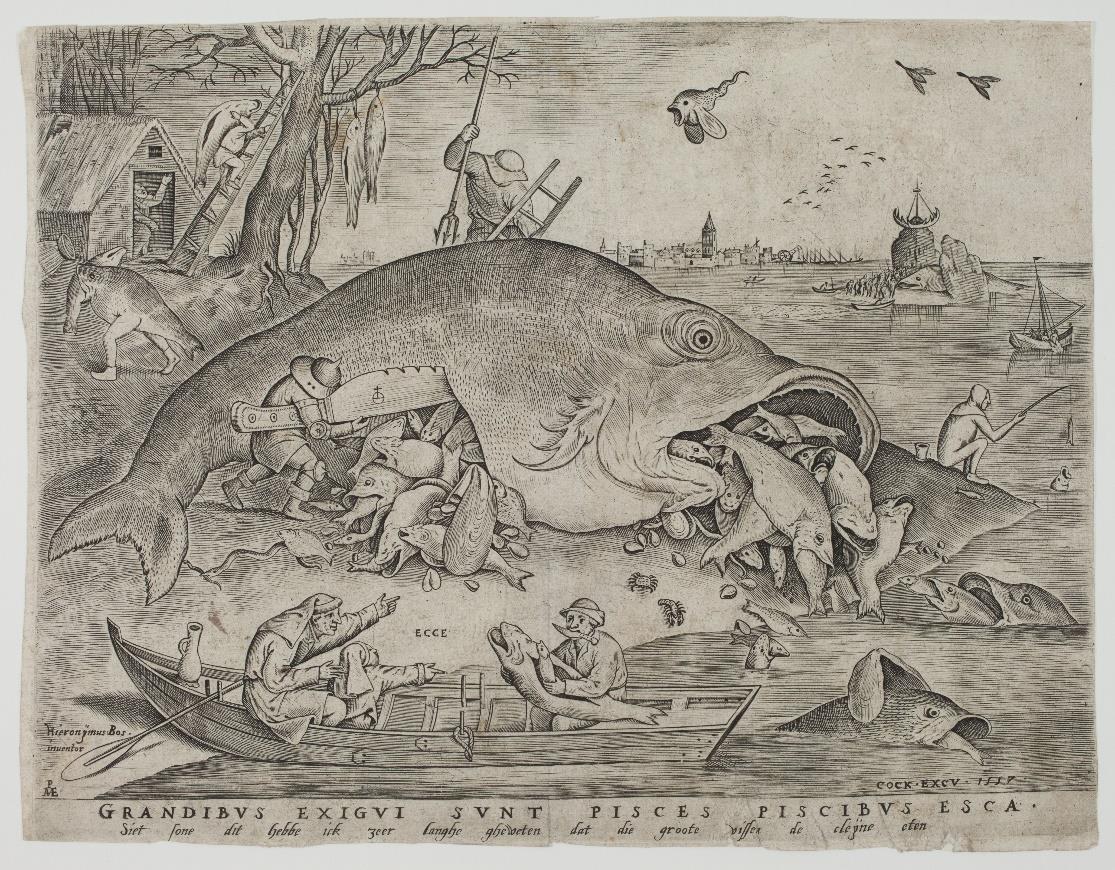
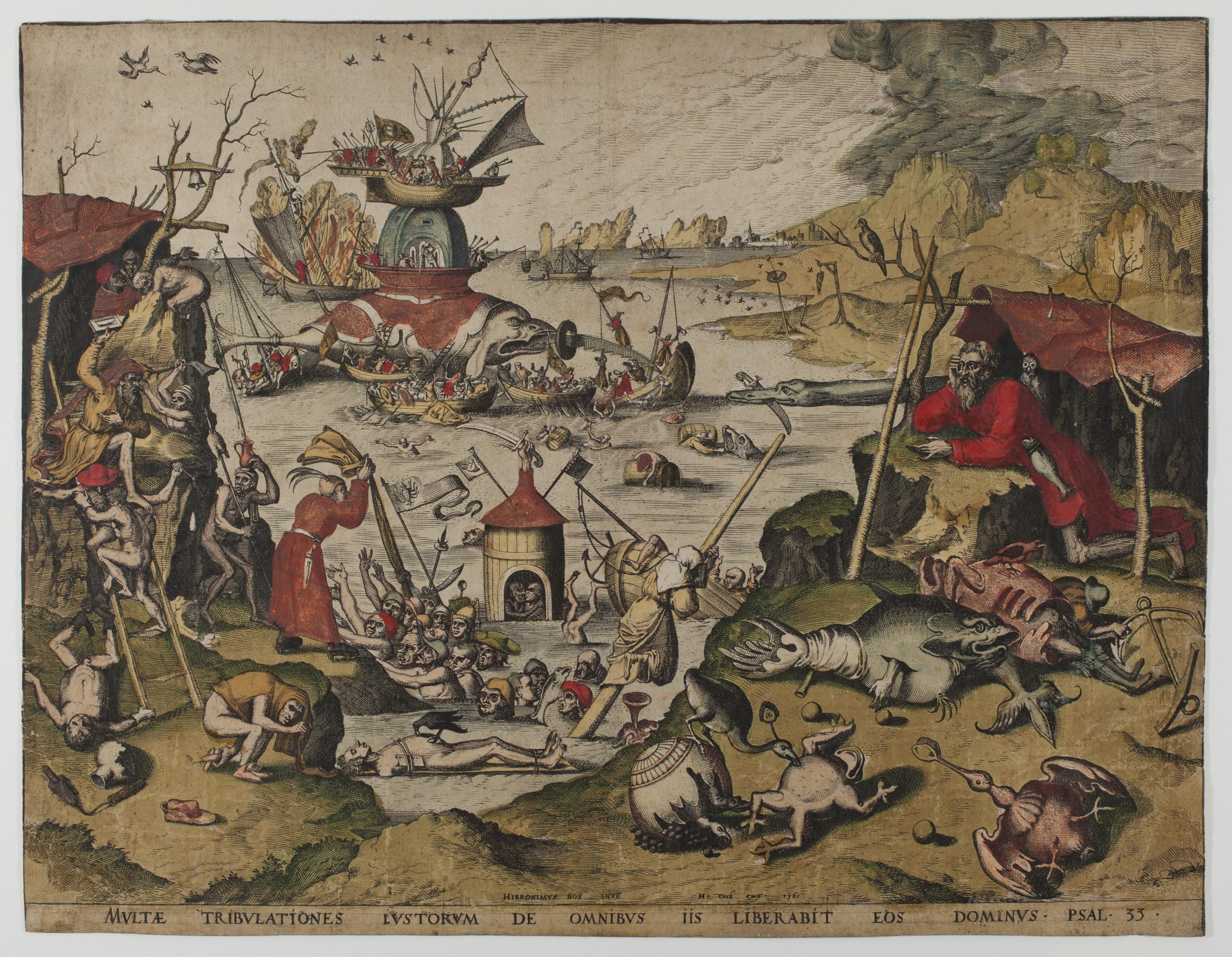



Etching and engraving, 430 x 332 mm. New Hollstein (Joannes and Lucas van Doetecum) 216, Riggs 9.
Fine impression printed on laid paper, enhanced at the time in gouache colours and cloth-backed.
Two small repaired losses of paper, without ink retouching, one in the lower left corner, the other on the right edge downwards, and a tiny repaired loss under the frog, some minor surface rubbing and small creases. Usual central vertical fold.
Very rare.
Several prints by the van Doetecum brothers in period colors are known, including an exceptional print of a procession engraved in thirty-three plates and a print of Landscape with Pilgrims at Emmaus, engraved after Bruegel (Painted prints: the revelation of color in Northern Renaissance & Baroque engravings, etchings & woodcuts, p. 42 et p. 159 to 161 ). Susan Dackerman notes in particular about the prints engraved after Bruegel: “In 1558, the Antwerp book publisher and dealer Christopher Plantin sent the Paris bookseller Martin Le Jeune several painted impressions of prints after Bruegel for him to distribute in France. The prints were among a batch published by Hieronymus Cock, the publisher of Bruegel’s design. Timothy Riggs surmines that Plantin, because he frequently hired colorists to paint the illustrations for the books he published, commissioned the coloring of these prints.” (Painted prints, pp. 160-161).


Our impression of The Temptation of Saint Anthony, contemporary with these prints after Bruegel, could have been colored in the same circumstances.
Traditionally described as the Temptation of Saint Anthony, the print could also represent the temptation of Saint Christopher. "The holy giant - who is indeed depicted taller than the other figures - is nonchalantly lying under a sod shelter, his staff resting on one of the branches supporting the roof. The hermit mentioned in the legends of Saint Christopher is indeed represented on the left, engaged in a fight against multiple assailants. This character does not usually appear in the stories about St. Anthony, who was himself a hermit." (Matthijs Ilsink, in Hieronymus Cock, La Gravure à la Renaissance, p. 252, translated by us).
In the estate of Volcxken Diericx, widow of Hieronymus Cock, the copper is described as "a copper plate of Saint Christopher by Hieronymus Bosch" [Een coperen plaete van Sinte-Christoffel van Jheronimus Bos]. The authors of the New Hollstein volumes, however, refer to another copper: "Een coperen plaete van Sint-Anthuenis Temptatie".





Sirens, Naiads and Tritons - c. 1563
Etching, 230 x 312 mm. Bartsch 17, “premières épreuves” [early impressions].
Rare impression from 1st state (of 2) before Anglo falco’s signature bottom left. Very fine impression printed on laid paper. Generally in excellent condition. A tiny stain above the left angel, a pale stain above the horses.
"These pieces are very difficult to find" wrote Bartsch about the engravings that he attributed to a certain "Angelo Falcone". The signature Anglo falco is nowadays read as that of the Verona painter and engraver Angelo Falconetto. Falconetto's prints are rare. The impressions of Mermaids, Naiads and Tritons are often printed in a dry and uneven manner. Our print is on the contrary well contrasted.
Bartsch notes that "this print is engraved according to a design attributed to Parmesan." (translated by us) Catherine Jenkins indeed underlines the influence of Parmigianino in the "sinewy and languid" style of the sea creatures, but she thinks that “Falconetto may have derived this small, animated group of frolicking sea creatures from a lost frieze design that was painted in a palace or villa in the Veneto. Elements of the composition, particularly the putto and dolphins along the lower edge, evoke the frieze adorning the salone centrale at the Palazzo Moneta (1558-1563) in Belfiore near Verona, the overall decoration of which Vasari attributed to the Veronese sculptor Bartolomeo Ridolfi.”


Catherine Jenkins recalls that this type of marine procession “had its roots in the classical marine thiasoi carved on ancient Roman sarcophagi”. She specifically notes that “the present motif of the Nereid viewed from behind riding on the back of a sea centaur […] appears on a marine sarcophagus that was in the collection of Cardinal Andrea della Valle during the sixteenth century, which inspired many Renaissance artists.” (Nadine Orenstein et al.: The Renaissance of etching, 2019, cat no.82, pp. 178-179).
Bernard Barryte underlines the virtuosity with which Falconetto has treated a complex scene: “in spite of the complicated relationships established between the various types of bodies, the etching has about it an air of effortless grace - the draftmanship is fluid and refined, the work of a practiced hand at the service of a lively imagination.” (Bernard Barryte: Myth, allegory, and faith: the Kirk Edward Long collection of mannerist prints, 2015, cat no. 59, p. 404).



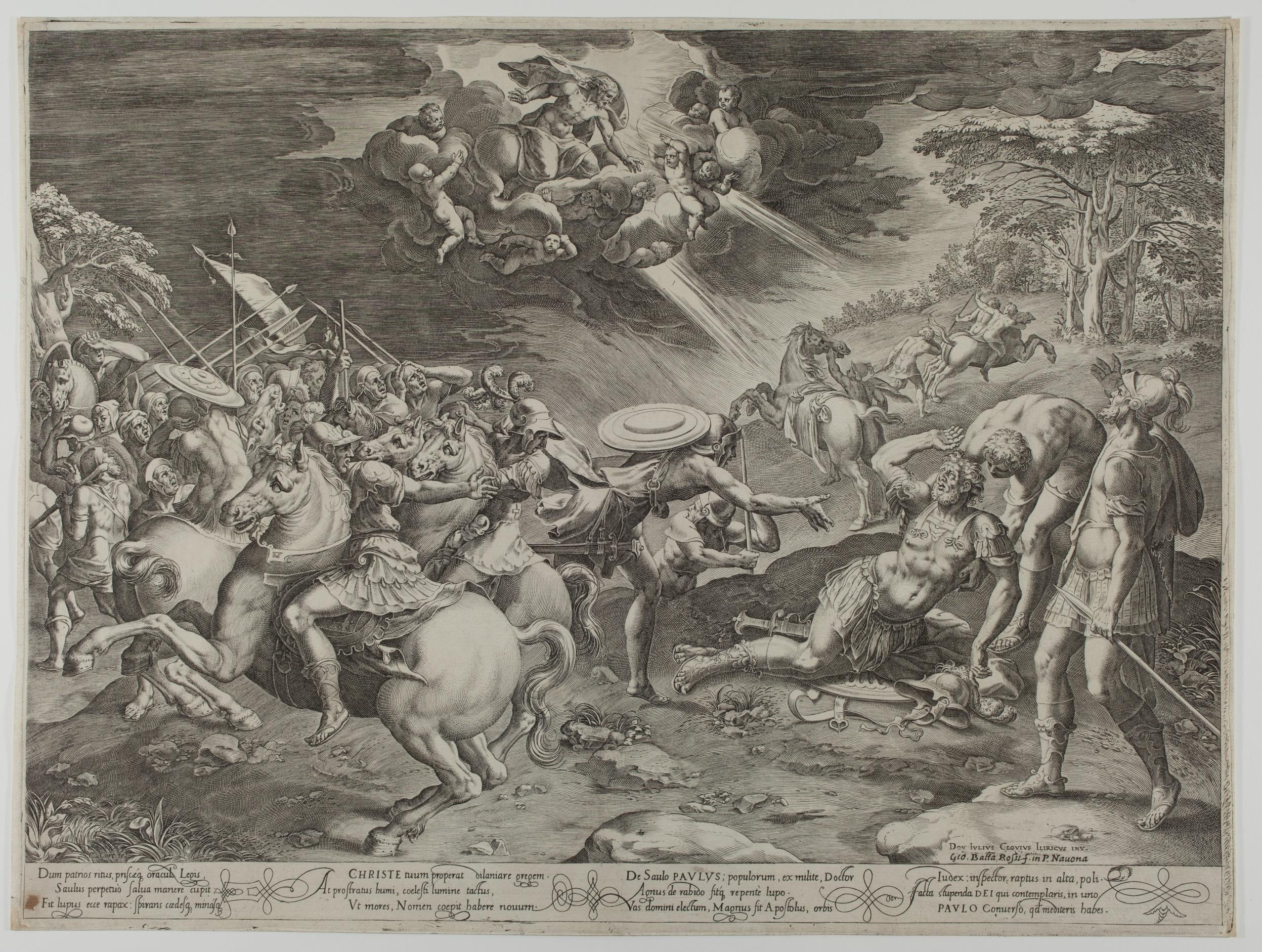

Engraving, 370 x 494 mm. New Hollstein 80, evoked but undescribed state, i.e. 3rd state (of 3).
Very rare impression with the address of Giovanni Battista de’ Rossi (c.1601 - 1678), replacing the address of Lorenzo Vaccari. The New Hollstein notice states: “Zani 1819-22 (vol. II/IX, p. 225) mentions an edition with the address of Vaccari erased and replaced by: Gio. Batta Rossi f. in P. Narma [sic].”. However, this edition is not indicated after the two states described and no impression is cited.
Fine impression printed on watermarked laid paper (double circle, difficult to see). Point of upper left corner reattached, small brown spot at lower left, otherwise in good condition. Thread margins all around the platemark.
Cornelis Cort regularly engraved prints after compositions by Giulio Clovio. “Clovio provided Cort with drawings which were based, as far as we know, on miniatures he had made himself. The design for the engraving The conversion of Paul, derives from a representation from one of the manuscripts illuminated by Clovio, the ‘Soane manuscript’, as it is called, which was commissioned in about 1535 by Cardinal Grimani.” (Manfred Sellink, Cornelis Cort, cat. 58, p. 167).


11. Bernardino PASSERI, attributed to (1540 - 1588 or 1530-1590 ?)
Humanae Vitae Finis - 1589 [Allegory on the end of man's life]
Engraving, 522 x 383 mm. Bartsch undescribed.

Impression with the address of Marcello Clodio (active c. 1587/1589). On an impression in the Metropolitan Museum of Art, Clodio's address has been erased and replaced by that of Tommaso Moneta (active in Rome c. 1588-1603). Our impression is therefore from the first state of the print.
Very rare.
Very fine impression on laid paper with a watermark close to Woodward 319, found on a map dating from c. 1590: letter M under a star within a C-type coat of arms.

Few small light foxmarks around Christ; very small repaired marginal tear, otherwise in very good condition. Thread margins all around the platemark.
Bartsch writes at the beginning of the catalog of Bernardino Passari's works, in volume 17 of Le Peintre graveur : "We can assure our readers that the seventy-eight pieces detailed in our catalog all belong to Bernardin Passari alone; but we will not maintain that there are no other pieces similarly made by him which may have escaped us." (translated by us)



Humanae Vitae Finis bears two authors' names, that of Sebastianus Fabrianensis (D. Sebastianus Fabrianen: inven:) and that of Bernardino Passeri (Bern: passarus figuravit).

According to the Abbot Pietro Zani, Sebastiano and Passeri are both inventors of the engraving, the first having provided the second with the theme and the entire conduct of the subject (Enciclopedia Metodica critico-ragionata delle belle arti, p. 39).
It is difficult to say whether Bernardino Passeri engraved his composition himself. The Metropolitan Museum of Art attributes his print to him.
The Rijksmuseum has another print published by Marcello Clodio, which is similar to Humanae Vitae Finis in size and title, also engraved in capital letters on its upper edge: Speculum Humanae Vitae.

The Mussel Shell - 1596
Engraving, 107 x 90 mm. Hollstein Dutch 240-287.
Plate from the Emblemata Saecularia series, first edition, dating from 1596, with the engraved number 13. In the second edition, dating from 1611, its number is 34. Very fine impression printed on laid paper. Small discrete traces of rubbing in the subject above the mussel shell, otherwise very good overall condition and good margins around the platemark (sheet: 168 x 120 mm).
Johann Theodor de Bry's print is a reversal of the composition of an engraving by Pieter van der Heyden based on a lost work by Hieronymus Bosch (Merrymakers Sailing in a Mussel Shell, 1562). The caption reads: Concha procellosum dic qua spe navigat aequor [Say in what hope this shell sails on the stormy waters]
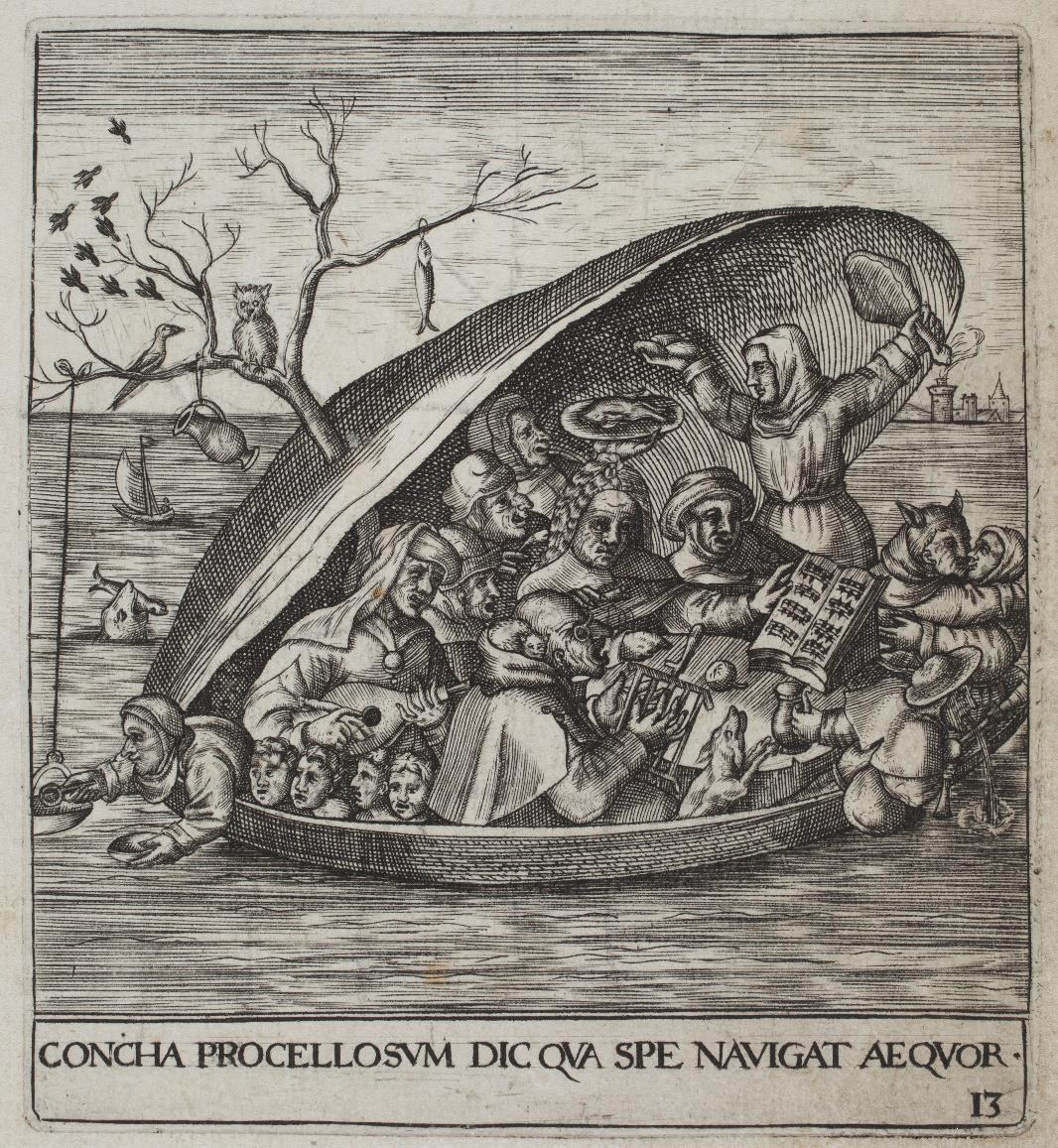

(1570 ? - 1601 ?)
Nymphaeum [The women’s bath]
Engraving, 228 x 175 mm. IFF p. 165, Le Blanc 4, Andresen 3.

Very fine impression printed on watermarked laid paper (watermark difficult to identify). In very good condition. A few small, barely visible creases, a small tear entering 10 mm inside the subject on the right edge. Fine impression with small margins around the platemark, unlike the impression kept in the Bibliothèque nationale de France which is trimmed (218 x 171 mm).

Extremely rare.
Almost nothing is known about the life of Robert Boissard. His engraved work is dominated by a set of portraits and a series of Mascarades published in 1597.
Nymphaeum depicts a group of seven women in a public bath. The theme of women in the bath is a recurrent one in old prints: either the artist uses a mythological illustration as a pretext, as in Venus Bathing Attended by her Nymphs, engraved by Jean Mignon after Luca Penni (Jenkins 34), or he treats the subject realistically, as in Three women in the bath-house by Bartel Beham (New Hollstein 49). These prints often contain erotic details. Here, a pair of scissors in a niche explicitly evokes a male sex.
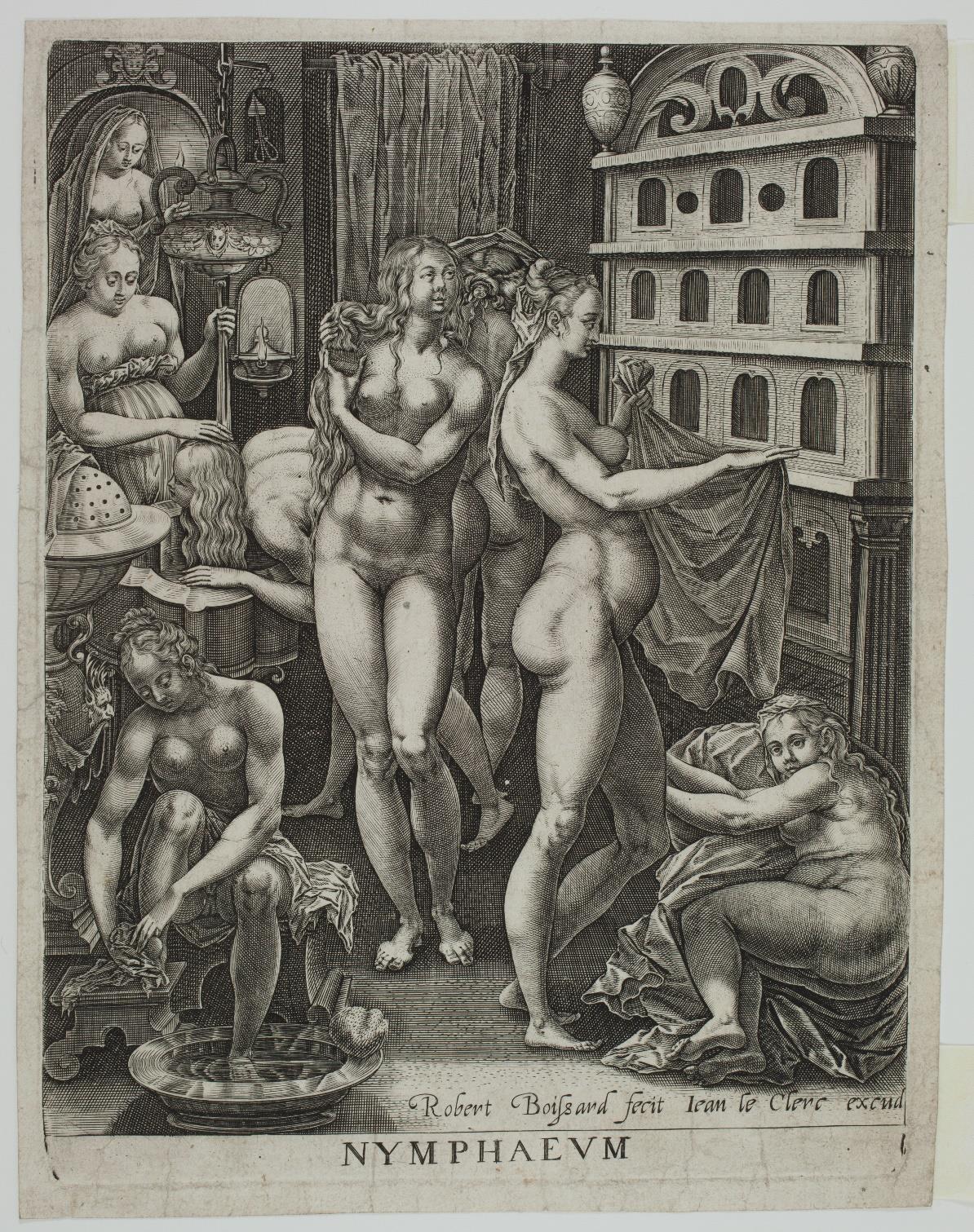

Etching, drypoint and engraving, 142 x 212 mm. Walch 7, 2nd state (of 4). Thuillier 26, 3rd state (of 5). Worthen, Reed 6, Griffiths, Hartley 6 ii/ii.
Impression of the 3rd state of 5 according to Jacques Thuillier: the plate finished and signed by Bellange. Before Leblond’s address. The first two states are known from only one proof each (London and Geneva).
Fine impression printed on laid paper. Impression trimmed on or just outside the composition. Persistent surface soiling, two tiny pinholes, otherwise in good condition.
“The depiction of the Virgin with a cradle and a distant figure, often seen through a doorway and identifiable as Joseph, occurs in numerous late sixteenth- and seventeenth-century prints of the Holy Family in Egypt (for example, Jan Sadeler after F. Sustris, Hollstein 303). […] Although the identification of the distant figure as Joseph is reasonably inferred from other prints of this subject, he is here rather enigmatic, to say the least, resembling the mysterious figures wandering anonymously about in the background of Bellange’s larger prints.” (Antony Griffiths and Craig Hartley: Jacques Bellange, c. 1575 - 1616, Printmaker of Lorraine, 1997, p. 60).
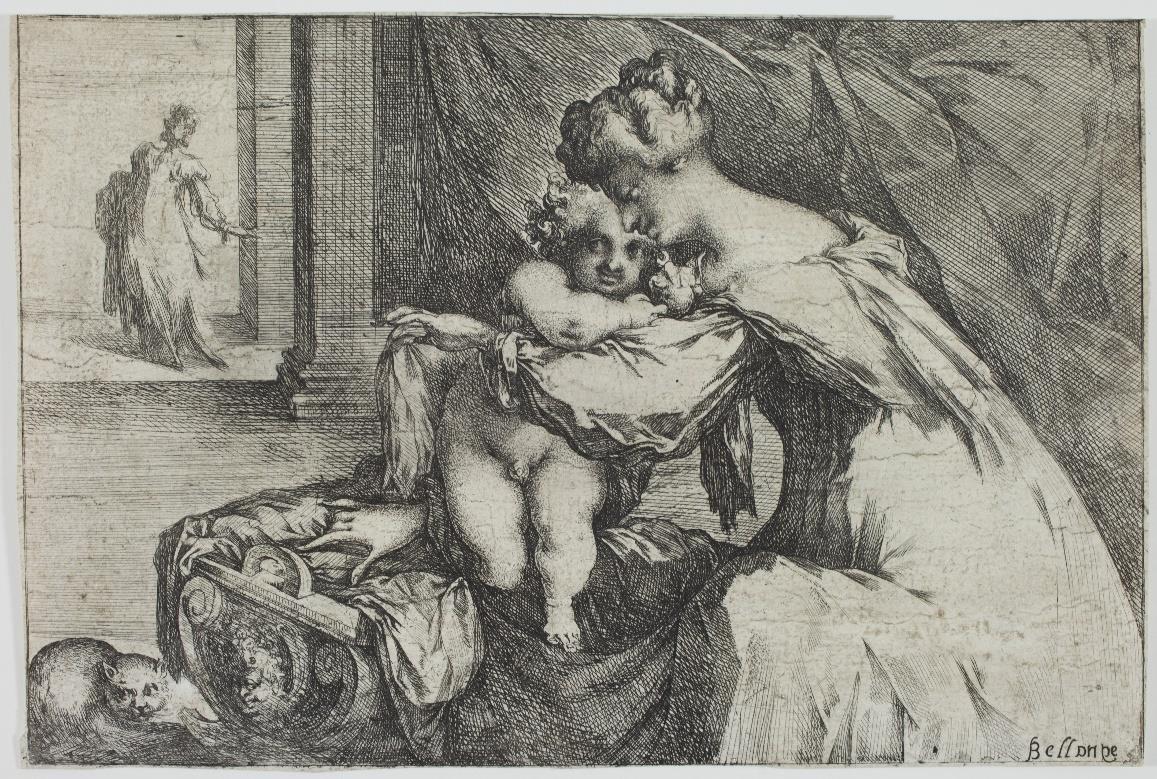

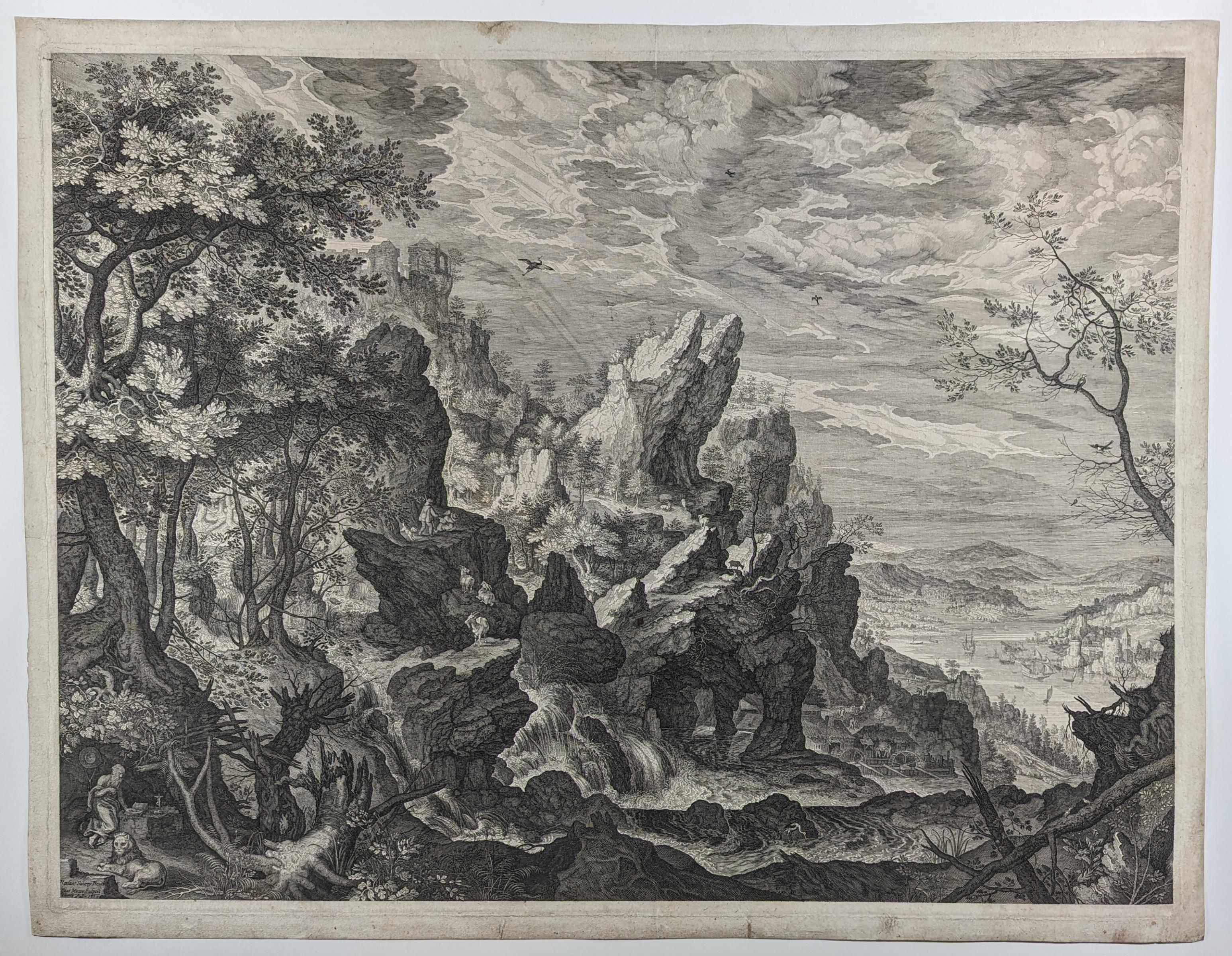



15. Isaac Major after Roelant SAVERY (c. 1576 - 1630/1636)
Mountainous landscape with St. Jerome - 1622
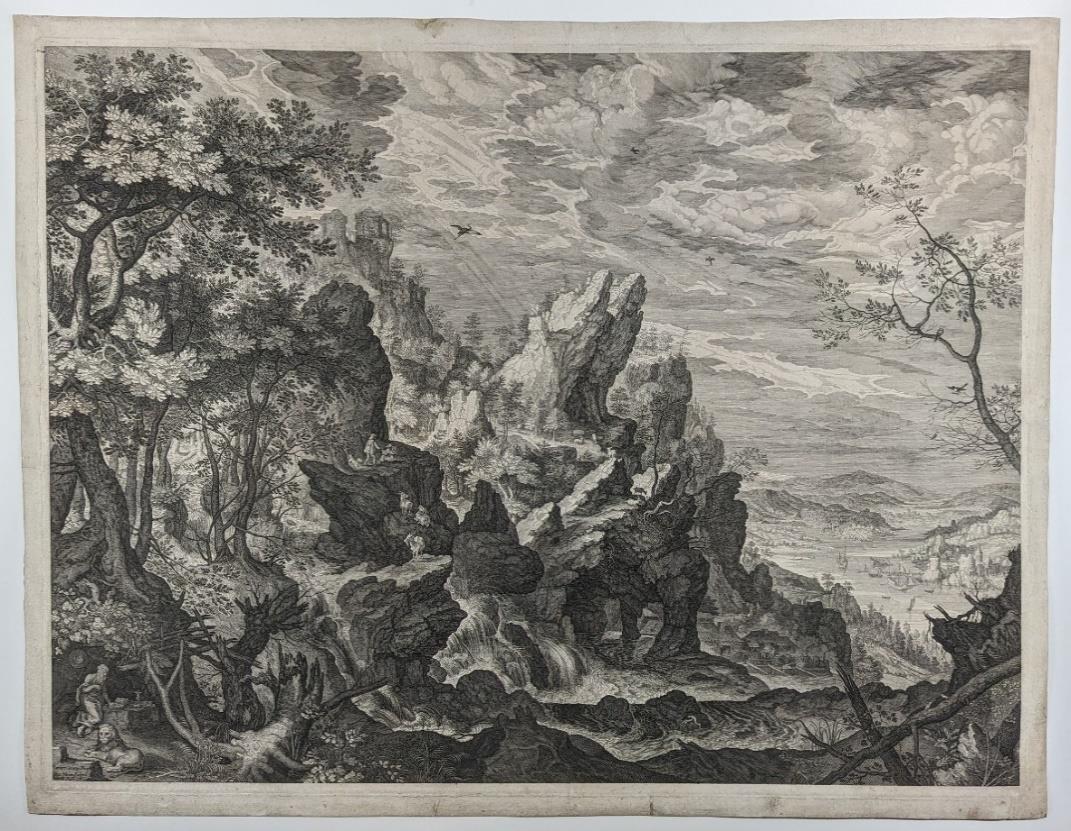
Etching and drypoint, 545 x 713 mm. Hollstein 7, 1st state (of 2); Le Blanc 12.
Impression of the 1st state (of 2) before Wagner’s address.

Very fine impression printed on laid paper. Three small marginal tears, one of which reaching the subject. One very small restored loss in the subject and a small spot of rust, otherwise in excellent condition. Small margins around the platemark (sheet: 577 x 745 mm).
The monumental Mountainous Landscape with Saint Jerome is the etched masterpiece of Isaak Major.

16. Jan van de VELDE II
(1593 - 1641)
The Market
Etching and engraving, 95 x 1270 mm and 95 x 1260 mm. Hollstein 139 to 146, 1st state (of 2); Franken-Kellen 100 to 107.
Uniform set of the two complete series in 1st state impressions, published by Jan van de Velde II, before the address of Claes Jansz. Visscher.

Extremely rare complete set consisting of two series of four plates each intended to be joined together in two strips.

Superb impressions printed on laid paper.

These two panoramas spectacular by their format and the richness of the details offer the animated spectacle of a market day. We notice a charlatan surrounded by a crowd of onlookers, merchants of pipes and tobacco, fruits and vegetables, fish, cheese, cattle, many customers who have come to see the goods or to stroll, converse or sit on the grass. Pilgrims approach them, children play together or fight. Eddy de Jongh observes that market scenes, which had been very popular in the Netherlands since the 16th century, were depicted more realistically in the 17th century, especially in the prints by Pieter van der Borcht and Jan van Velde.

(1606 - 1669)
Woman with a High Headdress Wrapped Around the Chin : Bust -
c. 1630
Etching, 71 x 58 mm. Bartsch 358, New Hollstein 58 ii/ii. Impression of the 2nd state (of 2) after reduction of the copperplate.

Fine impression printed on laid paper with thread margins around the platemark; the diagonal scratches on the left are clearly visible; pale foxmarks, a fragment of the upper right corner reattached, otherwise in good condition.
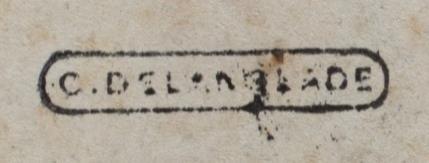
Provenance: Charles Delanglade (born in 1870) (Lugt 660).
Very rare print (Usticke RR+). Only two impressions of the 1st state before reduction of the copperplate on the right are known (Rijksmuseum, British Museum). In some impressions of the 2nd state the lower part left blank by Rembrandt has been trimmed.
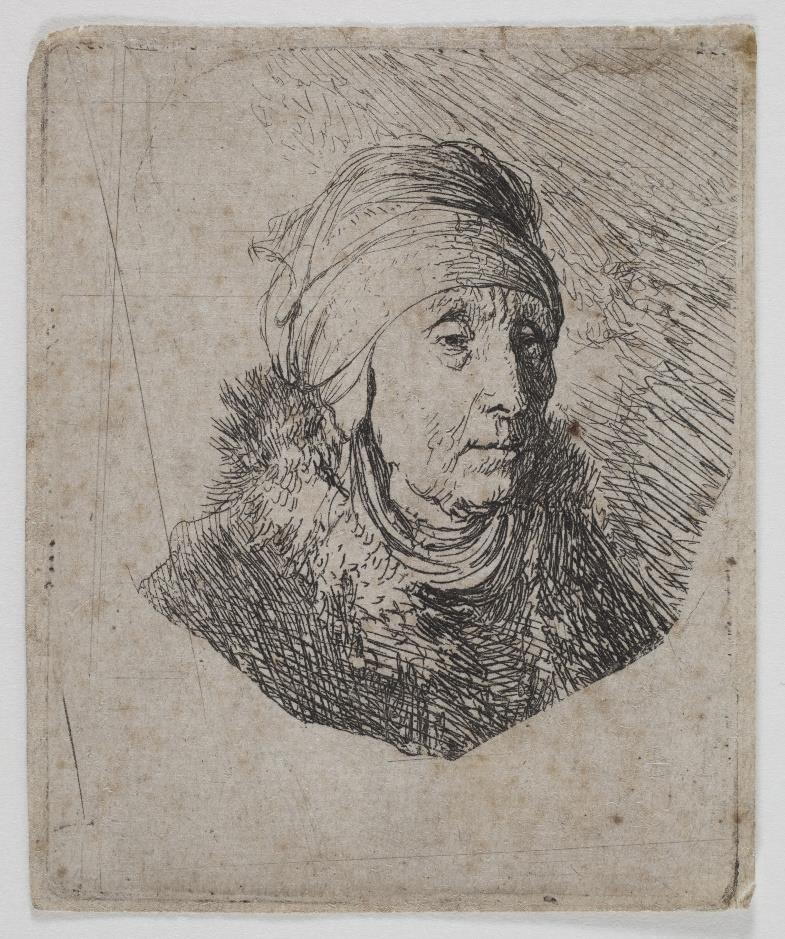

18. Cornelis GALLE the Younger (c. 1615 - 1678)
after Philippe de CHAMPAIGNE (1602 - 1674)
Vanitas
Engraving, 279 x 212 mm.
Very fine impression printed on watermarked laid paper (watermark: lion); trimmed on the borderline on the right and bottom, about 10 mm inside the subject at the top and 1 mm inside on the left. Two 40 mm repaired tears bottom, a long printing crease not visible on the front of the sheet, reinforced on the back.
Extremely rare.
This composition is based on the Vanity engraved by Jean Morin after Philippe de Champaigne, inverting it and tightening it, the format no longer being horizontal but vertical.


Exitus Acta probat [Allegory on Death]
Engraving, 132 x 200 mm (sheet). Hollstein undescribed. This print does not seem to correspond to Hollstein 147 ("Allegory on Death, after Nic. van der Horst"), which refers to the description in Le Blanc 39: “Le Temps tirant un rideau et montrant un miroir dans lequel on voit la Mort : Nic. van der Horst. P. en Haut.” [Time drawing a curtain and showing a mirror in which one sees Death: Nic. van der Horst. Vertically]
Very fine impression printed on watermarked laid paper (watermark: Foolscap with Five-Pointed Collar). One small tear of 18 mm summarily repaired on the lower edge and one of 9 mm on the right edge. A light stain at the bottom. Rare.


Marie-Rosalie Vanloo - c. 1764
Crayon manner printed in black and white on blue paper, 402 x 302 mm. Hérold 55a, 2nd state (of 5).
Impression of the 2nd state (of 5) before replacing the address of Bonnet, Pont St. Michel, in Paris, by that of the widow Chéreau.
Very fine impression. Roughly trimmed to the borderline. A few tiny pinholes in the subject, and a small crease in the upper right corner, otherwise in very good condition and freshness.
Provenance : Roland de Perthuis (1927 - 2016), his mark printed in black on the back (Lugt 4237).
From 1757, the printmaker and printer Jean-Charles François developed the technique of engraving in the chalk manner (imitating the sanguine drawing) by using in particular the roulette, which was used until then only to add some details to a print. This manner was imitated by Gilles Demarteau, Alexis Magny, Thérèse-Éléonore Lingée and Louis-Marin Bonnet who perfected the technique as Margaret Morgan Grasselli explains: “Bonnet was not content simply to turn out print after print in the standard chalk-manner technique. Instead, this inspired and determined innovator expanded the possibilities of the medium in a variety of directions. One of his first innovations was the formulation in about 1763 of a white printer's ink that could effectively imitate the appearance of white chalk and white gouache, but would not turn yellow or black over time. This new ink revolutionized chalk-manner


engraving and greatly expanded the types of drawings that could be reproduced in prints.” (Colorful impressions, p. 54).
Bonnet did not share the secret of his technique and was thus the only one to print with white ink (see on our site the detail of this technique in the description of our impression of the Première tête, aux trois crayons, engraved after Boucher (1765/1767) opposite).
The choice of paper was also important for the final result of the test. "Printing black-and-white impressions on blue paper was a favorite variant, for the blue of the paper not only added an extra dimension of color, but also enhanced the brightness of the whites and their contrast with the blacks." (Colorful impressions, p. 55).

Self-portrait at the age of twenty-eight, in bust, front - 1785
Engraving, etching and tools, 168 x 126 mm. Friedrich von Bartsch 23, Rieger 14, 6th state (of 6). Impression of the 6th state (of 6), with the engraved background.
Fine impression printed on wove paper. Some very light foxing in the margins. Good margins (sheet: 222 x 167 mm). Rare.
In 1785, at the age of twenty-eight, Adam Bartsch was not yet the author of the famous Peintre-graveur, which he published between 1803 and 1821. He was working at the Royal Court Library in Vienna, which he had joined after studying printmaking.


Head of an Amazon - 1819
Lithography, 265 x 170 mm.
Very rare and perhaps unique impression reversing black and white, printed on wove paper and annotated most probably by Nicolas-Henri Jacob: Le moyen d'encrage a été inversé [The way the stone is inked has been reversed] and Étude faite avec Sénéfelder dans mon atelier rue de l'Abbaye N°4 [Experiment made with Senefelder in my workshop rue de l'Abbaye No.4].
A small 15 mm tear on the left border of the sheet and a few marginal foxmarks, otherwise in very good condition. Good margins (sheet: c. 290 x 220 mm).
Aloys Senefelder invented lithography in 1796 in Munich. In 1819, he printed in Paris the French translation of the treatiseThe Art of Lithography (Vollstandiges Lehrbuch der Steindruckerei) published the previous year in Munich and Vienna. The same year, the work was enriched by a collection of twenty lithographic plates: Collection de plusieurs essais en dessins et gravures pour servir de Supplément à l'Instruction pratique de la Lithographie by Aloys Senefelder. These are examples, some executed by Senefelder himself, of lithographs reproducing pencil or pen drawings, etchings or woodcuts or musical scores. The Head of an Amazon in its usual versiont is plate XIV of this Collection.
This study bears witness to the extensive technical research carried out by Aloys Senefelder and the pioneers of lithography to perfect this still nascent art.



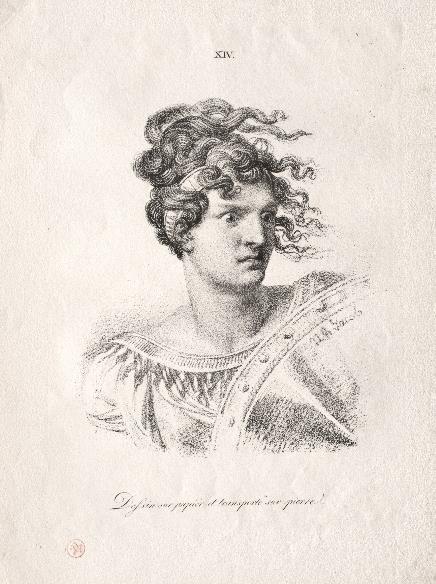
 L’art de la lithographie, plate XIV (The Cleveland Museum of Art)
L’art de la lithographie, plate XIV (The Cleveland Museum of Art)


High definiton picture visible on our website by clicking on the title of the works
1. Lucas CRANACH the Elder
David and Abigail - 1509
2. Hans Sebald BEHAM
Dido’s Suicide - 1520
3. Dirck Jacobsz. VELLERT
The Temptation of Christ - 1525
4. Léon DAVENT after LE PRIMATICE
A Sacrifice - c. 1540/45
5. Jean MIGNON after Luca PENNI
Cassandra Stopping Deiphobus from Killing Paris - c. 1544/1545
6. Sebastiano de VALENTINIS
Landscape with the Rest on the Flight into Egypt - c. 1550/1555
7. Pieter van der HEYDEN after Pieter BRUEGEL the Elder
Big fish eat little fish - 1557
8. Johannes et Lucas van DOETECUM after Hieronymus BOSCH
The Temptation of St. Anthony - 1561
9. Angelo FALCONETTO
Sirens, Naiads and Tritons - c. 1563
10. Cornelis CORT after Giorgio Giulio CLOVIO
Conversion of St Paul - 1576
11. Bernardino PASSERI
Humanae Vitae Finis - 1589

12. Johann Theodor de BRY
The Mussel Shell - 1596
13. Robert BOISSARD
Nymphaeum
14. Jacques BELLANGE
The Virgin and Child with Cradle
15. Isaac Major after Roelant SAVERY
Mountainous landscape with St. Jerome - 1622
16. Jan van de VELDE II
The Market
17. REMBRANDT HARMENSZ. VAN RIJN
Woman with a High Headdress Wrapped Around the Chin : Bust - c. 1630
18. Cornelis GALLE the Younger after Philippe de CHAMPAIGNE
Vanitas
19. Cornelis GALLE the Younger
Exitus Acta probat
20. Louis-Marin BONNET
Marie-Rosalie Vanloo - c. 1764
21. Adam BARTSCH
Self-portrait at the age of twenty-eight, in bust, front - 1785
22. Nicolas-Henri JACOB
Head of an Amazon - 1819
2023 © Copyright Sarah Sauvin